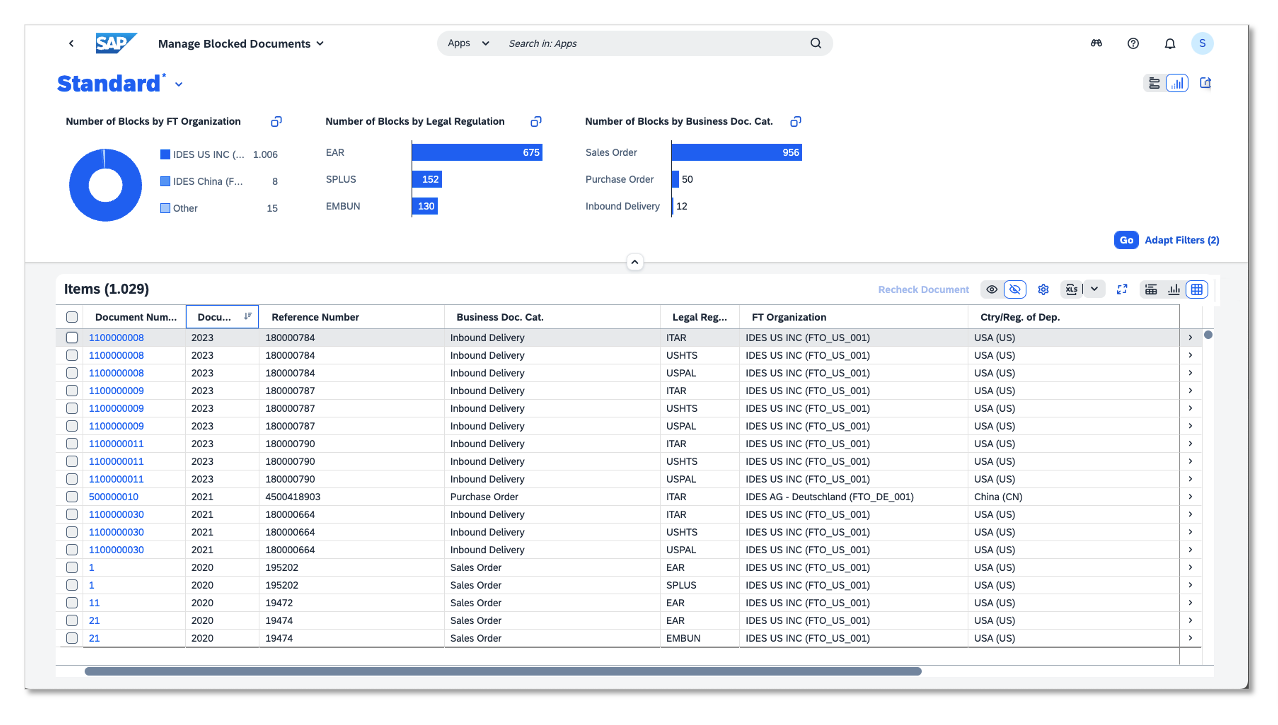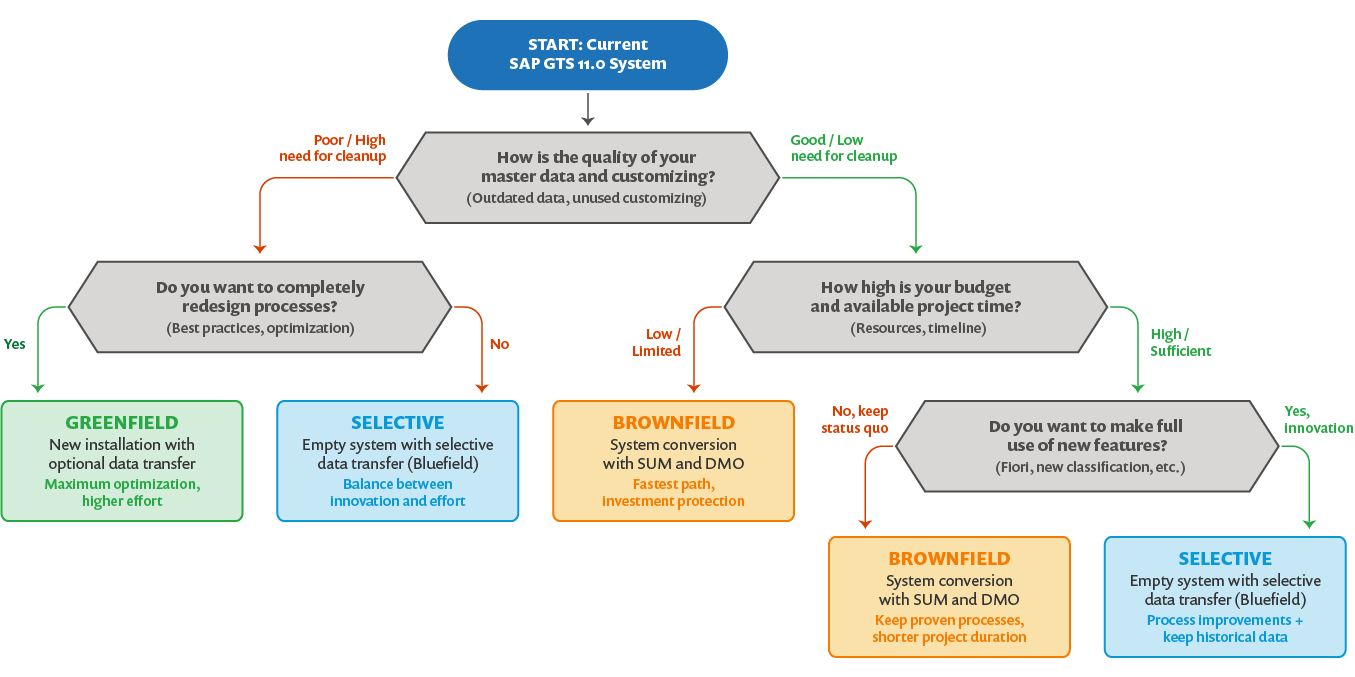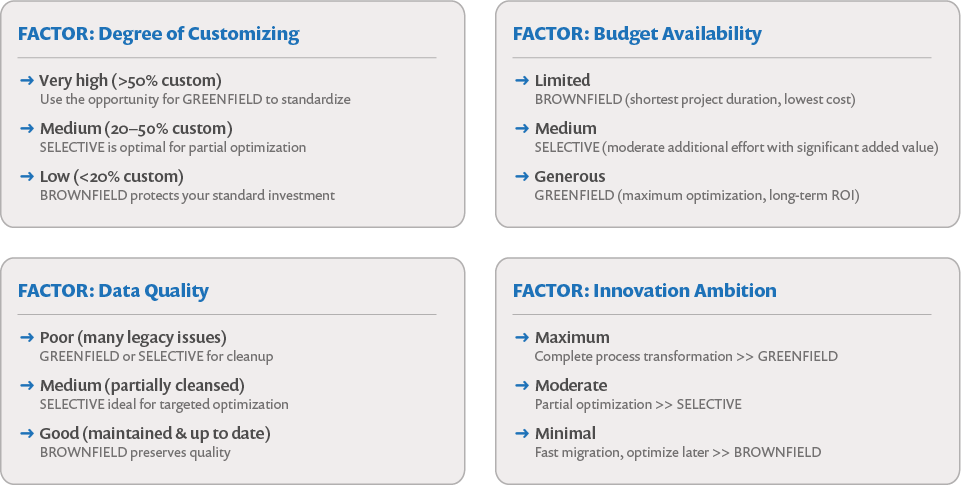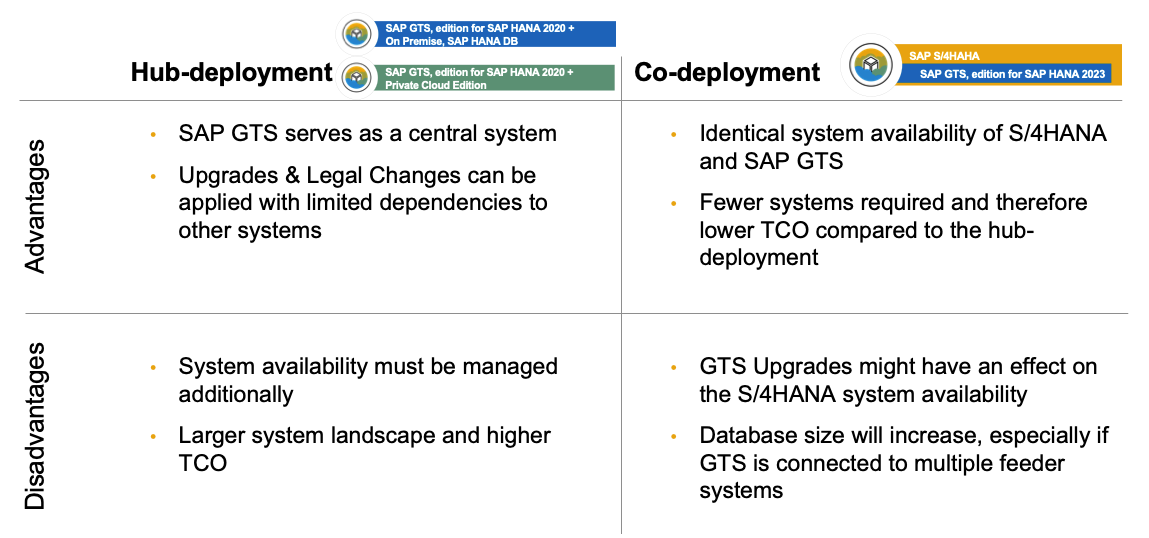
SAP GTS 11.0 to Edition for HANA: Step-by-Step Migration Guide
With the end of support for SAP GTS 11.0 approaching, many companies are facing migration to GTS Edition for HANA. This comprehensive guide supports you in all your decisions: from evaluating your current system to selecting the right migration strategy (greenfield, brownfield, or selective) to technical implementation. Learn all about new features and different deployment models.


Table of Contents:
- Evaluation of the current SAP GTS 11.0 System
- New Features in SAP GTS Edition for HANA 2023
- Comparison of Migration Strategies: Greenfield, Brownfield, Selective
- Technical Implementation with SUM, Stack.xml, and Readiness Check
- Deployment Models and Target Architecture
- Conclusion
- References
SAP GTS Edition for SAP HANA represents an important technological advancement that companies should implement by the end of 2025. With support for older versions coming to an end, many organizations are facing the challenge of migrating their Global Trade Services systems.
However, this migration is not only a technical necessity, but also offers significant advantages. Using HANA technology accelerates processes, enables real-time analysis, and unlocks new functionalities such as improved Fiori apps. Companies also benefit from an optimized status concept in trade compliance and more advanced classification logic.
In this comprehensive migration guide, we first look at evaluating your current SAP GTS 11.0 system. We then introduce the new features of the SAP GTS Edition for HANA and compare different migration strategies. In addition, you will gain detailed insights into the technical implementation and possible deployment models. This guide will support you in every decision on the path to a successful migration.
Evaluation of the current SAP GTS 11.0 System
Before migrating to the new SAP GTS Edition for HANA, you first need to thoroughly evaluate your existing SAP GTS 11.0 system. This evaluation forms the foundation for a successful conversion and minimizes risks during the migration project.
Functional analysis: compliance, customs, preference
The functional analysis begins with an inventory of all implemented modules. In the area of compliance management, you should document the configuration of sanctions list checks, embargo checks, and legal controls. These checks are crucial for detecting prohibited or restricted business transactions. Customs management supports the automated creation and transmission of customs documents as well as electronic communication with customs authorities. Of particular importance here is the review of transit systems (NCTS) and special customs procedures such as inward or outward processing.
The assessment should also review existing processes for preference processing and the exchange of long-term supplier declarations. Early analysis of functional coverage helps to avoid compliance risks after the end of support and identify potential for improvement.
Document customizing and in-house developments
The analysis of all customer-specific adaptations is crucial for migration preparation. Document in detail all user exits, customer-specific reports, and in-house developments. These elements must be checked for compatibility with the new environment. When migrating to SAP GTS Edition for HANA, changes to classifications, customs tariff tables, free trade agreements, and long-term supplier declarations (LLE) are necessary, which requires adjustments to existing in-house developments.
Although most integrations are backward compatible, the new version enables additional functions such as database persistence of GTS locks in S/4HANA, which may eliminate the need for previous adjustments.
Check integration with SAP ERP or S/4HANA
SAP GTS acts as a satellite system to which various upstream systems such as SAP ECC, SAP S/4HANA, or non-SAP systems can be connected. Check the existing integrations and interfaces. Bidirectional communication between the systems enables SAP GTS to send the results back to the upstream system. Synchronous checking of sales and purchasing documents and integration with SAP EWM and SAP TM systems is particularly important.
For companies that already use SAP GTS, there is no immediate need to convert the upstream system to S/4HANA. SAP GTS Edition for HANA can continue to be operated with SAP ERP as the upstream system.
Data quality and master data cleansing
High data quality is crucial for migration success. The changeover offers a good opportunity to identify and clean up outdated or incomplete data. SAP experts emphasize that data cleansing and harmonization are among the key challenges in migrations and that establishing data quality standards before the migration is essential [1].
Collect user feedback and usability issues
Involving end users is essential for a smooth transition. Systematically collect feedback on user experiences, pain points, and potential for improvement . The SAP GTS Edition for HANA brings fundamental changes to the user interface – from SAP GUI to SAP Fiori. This requires comprehensive change management to involve users at an early stage and address their concerns, questions, and reservations. The modern SAP Fiori interface enables intuitive control regardless of the end device, which benefits users in the long term. However, potential training needs should be identified to promote acceptance of the new solution.

New Features in SAP GTS Edition for HANA 2023
The SAP GTS Edition for HANA 2023 brings numerous technological innovations that make foreign trade significantly more efficient. The switch from the classic SAP GUI interface to modern Fiori technology not only enables intuitive operation, but also offers extended functionalities in all core areas of the system.
Fiori Apps: Manage Blocked Partners, Display Documents
Support Package 04 introduced an improved search function for central Fiori apps. In the "Manage Blocked Partners" app, users can now search specifically for people who have created or changed blocked partners [2]. The display of processors with change authorization in the sanctions list check area has also been optimized. Similar improvements can be found in the "Manage Blocked Documents" app, which now offers filter options for SPL processors, embargo processors, and legal control processors. The Fiori apps also enable device-independent control, allowing users to work more flexibly [3].

New status concept in trade compliance
Compliance management has been fundamentally revised and equipped with a new status concept. This means that service orders, service offers, subscription orders, and solution offers can now also be subjected to a compliance check [2]. An important new feature is the display of decision reasons: With the "Display Reason" and "Display Comment" buttons, users can now see why a particular document was blocked or released in the sanctions list check or embargo check [4].
LLE process optimization and source documents
The LLE (long-term supplier declaration) processes have been greatly simplified. A significant new feature is that LLE requests and LLE responses are now treated as independent objects. This means that LLEs can also be created without prior request documents [5]. Customer-specific communication types such as PDF or email can be stored for communication with suppliers. Particularly noteworthy is the integration of the former add-on "Identity Based Preference Processing" into the standard – the management of preference data for product identifiers is now an integral part [2].
Intrastat improvements
SAP GTS Edition for HANA 2023 introduces significant improvements in the area of Intrastat. In particular, Intrastat reporting has been fully implemented for Malta [2]. In addition, three additional user-defined fields are now available in Intrastat reporting items, which, at 20, 40, and 40 characters, are significantly larger than the previous fields [2]. This increases flexibility for country-specific requirements, such as for Italy and Bulgaria, where a third-party declarant system can now also be used [6]. The cross-system Intrastat function allows documents from Order Management to be transferred directly to SAP GTS [7].
Improved classification logic and extension of sanctions list checks
The classification logic has been fundamentally improved. Of particular note is the expanded screening of bank data. SWIFT/BIC codes and bank numbers can now be transferred to SAP GTS with bank master data and stored there as identification numbers in the business partner [4]. In addition, the bank details of customers and suppliers are also checked during screening – if a bank is blocked in the SPL check, all customers and suppliers with this bank in their bank details are automatically blocked as well [4]. Thanks to the improved SAP HANA Search, the sanctions list check can be performed up to six times faster, significantly reducing the time required [5].
However, the new cloud-optimized concept requires a higher degree of standardization, which may mean that existing special functions with individual custom code cannot simply be transferred 1:1.
Comparison of Migration Strategies: Greenfield, Brownfield, Selective
When migrating to SAP GTS Edition for HANA, companies are faced with a fundamental decision between three different implementation approaches, each of which offers specific advantages and disadvantages:

Greenfield: New installation with optional data transfer
The Greenfield approach means a complete restart on SAP GTS Edition for HANA. A new system is installed, processes are reconfigured and adapted, and new custom code is developed as needed. Optionally, selected data can be transferred from existing SAP GTS or legacy systems. This approach offers maximum optimization opportunities and full use of all the innovations of the new platform. However, it also requires the highest implementation effort and entails higher costs and a potential risk of data loss.
Selective migration: Empty system with selective data transfer
Selective data migration (also known as "Bluefield") involves first creating a copy of the existing SAP GTS system. All master and transaction data is then deleted, while customizing and custom code are retained. After converting this empty system to SAP GTS Edition for HANA, specific data can be transferred from the legacy system. This middle ground balances risks, costs, and innovation potential between pure Greenfield and Brownfield approaches and enables process improvements while preserving historical data.
Brownfield: System conversion with SUM and DMO
The Brownfield approach is the most commonly chosen migration method to date. It involves converting the existing system, including all data, customizations, and in-house developments, to SAP GTS Edition for HANA in an upgrade-like process. The Software Update Manager (SUM) and Database Migration Option (DMO) are used for technical implementation. This approach enables a shorter project duration and protects existing investments, but requires a "big bang" go-live and offers fewer opportunities for innovation.
SAP GTS migration decision tree
Use our decision tree to identify the right strategy for your company:

Additional factors for your decision

Scenarios A–D: Co-Deployment vs. Standalone
Depending on the initial situation, different migration scenarios arise:
- Scenario A: Migration from SAP GTS 11.0 (co-deployment on SAP ECC) to SAP GTS Edition for HANA (standalone). This first requires the establishment of a standalone SAP GTS 11.0 instance.
- Scenario B: Migration from SAP GTS 11.0 (co-deployment on SAP ECC) to SAP GTS Edition for HANA (co-deployment on S/4HANA). It should be noted that SAP GTS Edition for HANA can only be installed in a separate client.
- Scenario C: Migration from SAP GTS 11.0 (standalone) to SAP GTS Edition for HANA (standalone), whereby various options exist depending on the existing database.
- Scenario D: Migration from SAP GTS 11.0 (standalone) to SAP GTS Edition for HANA (co-deployment on S/4HANA). This requires special DMLT (Data Management and Landscape Transformation) services from SAP.
Licensing and infrastructure considerations
For on-premises licenses, customers can choose between standalone and co-deployment. For cloud implementations, there are two options available: a standalone SKU with a dedicated cloud environment or the more cost-effective co-deployment SKU without its own infrastructure, which requires an existing S/4HANA Private Cloud system. It should be noted that co-deployment creates dependencies between S/4HANA and SAP GTS with regard to upgrades and service packs. An upgrade of S/4HANA or the underlying HANA database automatically triggers an upgrade of the SAP GTS Edition for HANA.

Technical Implementation with SUM, Stack.xml, and Readiness Check
The technical migration to SAP GTS Edition for HANA requires careful preparation and the use of special SAP tools. Unlike conventional updates, this is a complete reimplementation with its own technical requirements.
Prerequisites: Unicode, AS ABAP, HANA DB
It is important to note that SAP GTS Edition for HANA is a completely new version and not an update to an existing GTS 11.0 system [8]. The migration requires a Unicode-enabled system [9]. If your system is not yet Unicode-enabled, you must first perform a Unicode conversion [10]. You also need a pure ABAP stack – dual stack systems must be split beforehand [11]. The SAP HANA database is also mandatory, while no S/4HANA is required as a pre-system [8].
Readiness check with /SAPSLL/READINESS_CHK_V8000
The readiness check is a crucial tool for preparing for migration. To do this, implement the program /SAPSLL/READINESS_CHK_V8000, which is provided with the OSS note 3033398 [12]. This check must be performed on a production-like system or the production system itself and provides a detailed list of issues that must be resolved before migration [13]. Among other things, the Readiness Check checks for:
- Incomplete validity periods in product classification (Check ID #06) [14]
- Use of unsupported application areas (Check ID #08) [15]
- Inconsistent timestamps in database tables [12]
Stack.xml generation in the Maintenance Planner
The Stack.xml file is created in the Maintenance Planner and is required for the Software Update Manager (SUM). All steps must be performed in a single transaction [13]:
- Select "Uninstall Add-Ons" and select your installed SAP GTS version
- Select "Plan a Conversion to SAP S/4HANA"
- Select "SAP GTS, edition for SAP HANA 2023" and then "GTSCORE"
For SAP GTS Edition for HANA, you should select "Install an SAP S/4HANA FOUNDATION system" when running the Maintenance Planner, as this option is required [16].
SUM 2.0 SP16+ and SPAM 85+ requirements
For the technical implementation of the migration, you need at least SUM 2.0 SP16 and SPAM version 85 or higher [13]. Please note that the Zero Downtime Option (ZDO) is not supported for the conversion [13]. In addition, for the conversion process after system downtime, you should select either a Support Package Level of SP20 or higher for the software component ST-PI 740 in the target stack [13].
Data model changes and custom code adaptation
Data model changes must be taken into account when migrating to SAP GTS Edition for HANA. Due to the differences between SAP GTS 11.0 and the Edition for HANA, customer-specific developments must be adapted [13]. These adaptations should be documented in transport requests so that they can be imported into other systems such as test and production later on [13]. In some cases, certain in-house developments may even need to be deleted if they are based on SAP standard functionalities that are no longer supported [13].
Deployment Models and Target Architecture
When planning your SAP GTS Edition for HANA architecture, there are various deployment models to choose from, each with different technical and organizational requirements.
Standalone vs. co-deployment: advantages and disadvantages
While SAP GTS is traditionally operated as a standalone system, the 2023 edition also offers the option of co-deployment on S/4HANA. This model reduces infrastructure costs and lowers overall operating expenses. However, even with co-deployment, GTS remains logically separate and requires the same integration steps as the standalone version [17]. In addition, GTS upgrades can affect S/4HANA system availability and vice versa [18].

>> Click on the image to go to the source (SAP Community)
Embedded vs. hub deployment for Fiori
There are two options for the Fiori interface: embedded deployment (backend and frontend on one server) or hub deployment (frontend on a central hub server). SAP expressly recommends embedded deployment for SAP Fiori in conjunction with GTS Edition for HANA [13].
Cloud migration with HSR or DMO System Move
Several options are available for cloud migration: Database Migration Option (DMO) with System Move enables the system to be moved to another environment [19], while SAP HANA HSR with backup/restore initialization is useful when network bandwidth is limited [19].
Feeder systems: SAP ERP, S/4HANA, TM, EWM
SAP GTS acts as a satellite system to which various upstream systems can be connected: SAP ERP, S/4HANA, SAP TM, and EWM [13]. The standard interfaces use remote function calls (RFC), which means that upstream systems can be changed at a later date without any problems [20].

N+1 landscape for DEV, TEST, and PROD
An extended N+1 landscape is required for the conversion. This means dual maintenance with two different development and test environments until go-live [13]:
- DEV: Original system (GTS 2020)
- DEV+1: Copy with upgrade to GTS 2023
- TEST and TEST+1 analog
- PROD: Direct upgrade

Conclusion
Migration to SAP GTS Edition for HANA is undoubtedly a complex but unavoidable task for companies using SAP GTS 11.0. During the migration process, existing systems must first be thoroughly analyzed. This includes functional testing of all modules, documentation of customizing elements, and evaluation of existing integrations.
It is particularly important to clean up master data before migration, as this can optimize processes and reduce costs. The new edition offers numerous advantages in this regard: improved Fiori apps, a revised status concept in trade compliance, optimized preference processes, and more powerful classification logic.
The choice of the appropriate migration strategy depends largely on individual requirements. Greenfield approaches offer maximum optimization opportunities but require greater effort. Brownfield migrations protect existing investments but allow for less innovation. Selective migration strikes a balance between the two aspects and enables selective data transfer with partial process optimization.
From a technical perspective, the changeover requires special preparations. The readiness check with the program /SAPSLL/READINESS_CHK_V8000 identifies potential obstacles at an early stage. Migration then takes place using SUM 2.0 and the corresponding Stack.xml configuration.
Depending on the company's situation, careful consideration should be given to standalone and co-deployment models. The standalone model offers greater independence, while co-deployment on S/4HANA reduces infrastructure costs but creates mutual dependencies.
With support for older versions coming to an end, companies should complete their migration to SAP GTS Edition for HANA by Q1 2026. Early planning, careful preparation, and selecting the right migration approach are therefore key to success. Companies that proactively manage this transition will not only benefit from compliance security, but also from significantly improved functions and performance features of the new platform.
Would you like to leverage the potential of SAP GTS for your company? Our team of experts at Tuleva AG will be happy to assist you in selecting the right migration strategy and implementing it. Contact us for a no-obligation consultation and learn how you can make your foreign trade processes more efficient, secure, and future-proof.
References
[1] - https://community.sap.com/t5/enterprise-resource-planning-blog-posts-by-sap/sap-s-4hana-data-migration-and-master-data-management-best-practices-with/ba-p/13688680 [2] - https://help.sap.com/doc/7537d1e7806941c894791e889f3897d3/2023.004/de-DE/b1ce7d3ed85f48008b29d7f2cd106e3b_de.pdf [3] - https://help.sap.com/doc/7537d1e7806941c894791e889f3897d3/2023.005/en-US/b1ce7d3ed85f48008b29d7f2cd106e3b_en.pdf [4] - https://help.sap.com/doc/7537d1e7806941c894791e889f3897d3/2023.005/en-US/b1ce7d3ed85f48008b29d7f2cd106e3b_en.pdf [5] - https://wts.com/de-de/publishing-article/zoll-it-digitalisierungsloesungen-neuerungen-in-sap-global-trade-services~publishing-article [6] - https://userapps.support.sap.com/sap/support/knowledge/en/3541673 [7] - https://community.sap.com/t5/supply-chain-management-blog-posts-by-members/sap-global-trade-services-edition-for-hana-key-features-and-benefits/ba-p/14119523 [8] - https://www.wsw.de/en/wsw-knowledge/sap-gts-edition-for-hana-what-you-need-to-know-before-migration/ [9] - https://www.epiuselabs.com/de/sap-landscape-optimization-blog/unicode-als-s4hana-voraussetzung [10] - https://help.sap.com/doc/2b87656c4eee4284a5eb8976c0fe88fc/2023/en-US/CONV_OP2023.pdf [11] - https://www.epiuselabs.com/de/sap-landscape-optimization-blog/s/4hana-conversion [12] - https://www.saptechnicalguru.com/gts-edition-for-hana-readiness-check/ [13] - https://community.sap.com/t5/financial-management-blog-posts-by-members/basis-view-on-upgrade-conversion-to-sap-gts-e4h-2023-gts-ed-for-sap-hana/ba-p/13556093 [14] - https://userapps.support.sap.com/sap/support/knowledge/en/3474557 [15] - https://userapps.support.sap.com/sap/support/knowledge/en/3479546 [16] - https://community.sap.com/t5/financial-management-q-a/maintenance-planner-gives-an-error-for-sap-gts-edition-for-sap-hana/qaq-p/12600373 [17] - https://community.sap.com/t5/financial-management-blog-posts-by-sap/what-you-need-to-know-when-chosing-between-co-deployment-or-standalone-sap/ba-p/13574527 [18] - https://globale-trade-services.com/content/what-is-new-in-sap-global-trade-services-edition-for-sap-hana/ [19] - https://docs.aws.amazon.com/sap/latest/sap-hana/migrating-hana-tools.html [20] - https://community.sap.com/t5/financial-management-blog-posts-by-members/establishing-connection-between-sap-feeder-system-and-sap-gts-system/ba-p/13254925


